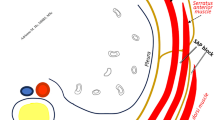Abstract
Blunt thoracic injury (BTI) constitutes a common presentation in emergency department: rib fractures are the most common injuries. Chest X-ray (CXR) has a limited sensitivity to identify rib fractures. We perform this retrospective study in our emergency department collecting all patients with BTI during an 18-month period. PoCUS was performed prior to acquire CXR or CT. We evaluated 1672 patients with BTI, and we reported rib fractures in 689 patients (41.21%). PoCUS was performed in 190 patients. PoCUS in emergency medicine has an increasing role, especially in BTI, but less clear is its role in detecting ribs fracture. PoCUS seems to be an effective method for diagnosing rib fracture in patients with blunt chest trauma if collaborative and with a well-isolated trauma. We used the trick of patients’ self-positioning probe in the most painful site, and this could reduce the time and the pain of the examination.

Similar content being viewed by others
References
Shields JF, Emond M, Guimont C, Pigeon D (2010) Acute minor thoracic injuries: evaluation of practice and follow-up in the emergency department. Can Fam Physician 56(3):e117–e124
Rostas JW, Lively TB, Brevard SB, Simmons JD, Frotan MA, Gonzalez RP (2016) Rib fractures and their association with solid organ injury: higher rib fractures have greater significance for solid organ injury screening. Am J Surg. https://doi.org/10.1016/j.amjsurg.2016.08.002
Lalande É, Guimont C, Émond M, Parent MC, Topping C, Kuimi BL, Boucher V, Le Sage N (2016) Feasibility of emergency department point-of-care ultrasound for rib fracture diagnosis in minor thoracic injury. CJEM 3:213–219. https://doi.org/10.1017/cem.2016.383
Rainer TH, Griffith JF, Lam E et al (2004) Comparison of thoracic ultrasound, clinical acumen, and radiography in patients with minor chest injury. J Trauma 56:1211–1213
Chardoli M, Hasan-Ghaliaee T, Akbari H et al (2013) Accuracy of chest radiography versus chest computed tomography in hemodynamically stable patients with blunt chest trauma. Chin J Traumatol 16:351–354
Hwang EG, Lee Y (2016) Simple X-ray versus ultrasonography examination in blunt chest trauma: effective tools of accurate diagnosis and considerations for rib fractures. J Exerc Rehabil 12(6):637–641. https://doi.org/10.12965/jer.1632840.420 (eCollection)
Cho SH, Sung YM, Kim MS (2012) Missed rib fractures on evaluation of initial chest CT for trauma patients: pattern analysis and diagnostic value of coronal multiplanar reconstruction images with multidetector row CT. Br J Radiol 85:e845–e850. https://doi.org/10.1259/bjr/28575455
Swaid F, Peleg K, Alfici R, Olsha O, Jeroukhimov I, Givon A, Israel Trauma Group, Kessel B (2014) The severity of liver injury following blunt trauma does not correlate with the number of fractured ribs: an analysis of a national trauma registry database. Surg Today 45(7):846–850. https://doi.org/10.1007/s00595-014-0975-4 (Epub 2014 Jul 5)
Boris K, Forat S, Itamar A, Oded O, Kobi P, Adi G, Igor J, Israel Trauma Group, Ricardo A (2014) Increasing number of fractured ribs is not predictive of the severity of splenic injury following blunt trauma: an analysis of a National Trauma Registry database. Injury 45(5):855–858. https://doi.org/10.1016/j.injury.2013.12.011 (Epub 2014 Jan 8)
Livingston DH, Shogan B, John P, Lavery RF (2008) CT diagnosis of rib fractures and the prediction of acute respiratory failure. J Trauma 64(4):905–911. https://doi.org/10.1097/TA.0b013e3181668ad7
Moore CL, Copel JA (2011) Point-of-care ultrasonography. N Engl J Med 364(8):749–757. https://doi.org/10.1056/NEJMra0909487
Wilkerson RG, Stone MB (2010) Sensitivity of bedside ultrasound and supine anteroposterior chest radiographs for the identification of pneumothorax after blunt trauma. Acad Emerg Med 17(1):11–17. https://doi.org/10.1111/j.1553-2712.2009.00628.x
Nagarsheth K, Kurek S (2011) Ultrasound detection of pneumothorax compared with chest X-ray and computed tomography scan. Am Surg 77(4):480–484
Lichtenstein DA, Menu Y (1995) A bedside ultrasound sign ruling out pneumothorax in the critically ill: lung sliding. Chest 108(5):1345–1348
Blaivas M, Lyon M, Duggal S (2005) A prospective comparison of supine chest radiography and bedside ultrasound for the diagnosis of traumatic pneumothorax. Acad Emerg Med 12(9):844–849
Kara M, Dikmen E, Erdal HH et al (2003) Disclosure of unnoticed rib fractures with the use of ultrasonography in minor blunt chest trauma. Eur J Cardiothorac Surg 24:608–613
Rostas JW, Lively TB, Brevard SB, Simmons JD, Frotan MA, Gonzalez RP (2016) Rib fractures and their association with solid organ injury: higher rib fractures have greater significance for solid organ injury screening. Am J Surg pii S0002–9610(16):30468–30478. https://doi.org/10.1016/j.amjsurg.2016.08.002
Kerr-Valentic MA, Arthur M, Mullins RJ et al (2003) Rib fracture pain and disability: can we do better? J Trauma 54:1058–1063
Gordy S, Fabricant L, Ham B et al (2014) The contribution of rib fractures to chronic pain and disability. Am J Surg 207:659–662
DeLuca SA, Rhea JT, O’Malley TO (1982) Radiographic evalua-tion of rib fractures. AJR Am J Roentgenol 138:91–92. https://doi.org/10.2214/ajr.138.1.91
Dubinsky I, Low A (1997) Non-life-threatening blunt chest trauma: appropriate investigation and treatment. Am J Emerg Med 15:240–243
Lee WS, Kim YH, Chee HK, Lee SA (2012) Ultrasonographic evaluation of costal cartilage fractures unnoticed by the conventional radiographic study and multidetector computed tomography. Eur J Trauma Emerg Surg 38:37–42
Griffith JF, Rainer TH, Ching AS, Law KL, Cocks RA, Metreweli C (1999) Sonography compared with radiography in revealing acute rib fracture. AJR Am J Roentgenol 173:1603–1609
Hurley ME, Keye GD, Hamilton S (2004) Is ultrasound really helpful in the detection of rib fractures? Injury 35(6):562–566
Chan SS (2009) Emergency bedside ultrasound for the diagnosis of rib fractures. Am J Emerg Med 27(5):617–620. https://doi.org/10.1016/j.ajem.2008.04.013
Turk F, Kurt AB, Saglam S (2010) Evaluation by ultrasound of traumatic rib fractures missed by radiography. Emerg Radiol 17:473–477
Author information
Authors and Affiliations
Corresponding author
Ethics declarations
Conflict of interest
The authors declare that they have no competing interests.
Rights and permissions
About this article
Cite this article
Riccardi, A., Spinola, M., Ghiglione, V. et al. PoCUS evaluating blunt thoracic trauma: a retrospective analysis of 18 months of emergency department activity. Eur J Orthop Surg Traumatol 29, 31–35 (2019). https://doi.org/10.1007/s00590-018-2283-y
Received:
Accepted:
Published:
Issue Date:
DOI: https://doi.org/10.1007/s00590-018-2283-y




